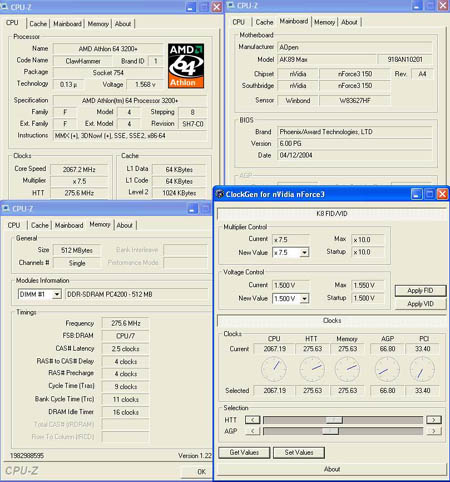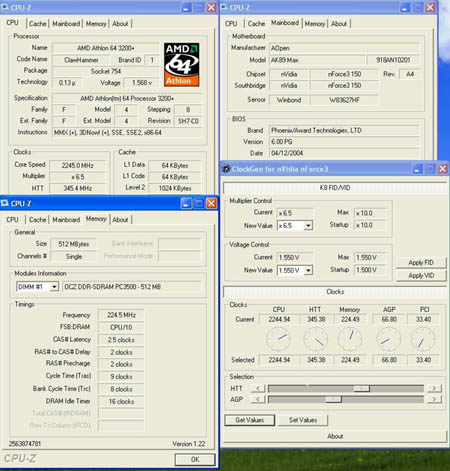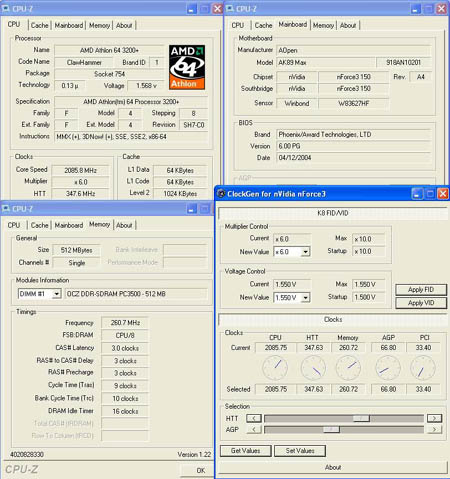AOpen AK89 Max: From Ugly Duckling to Swan
by Wesley Fink on April 21, 2004 4:16 PM EST- Posted in
- Motherboards
AOpen AK89 Max: Extreme Overclocking 2
While it is normally better to have the FSB adjustments in the BIOS, there are other methods available to get beyond the FSB limit. The AK89 Max is capable of much more than the 250 FSB available in the BIOS, so we used a free windows-based utility called Clock Gen from www.cpuid.com to reach higher FSB. There is a version available for nForce3-150 chipsets.Using DDR533 (PC4200) memory, we were able to run the memory at DDR533 and the AK89 Max at 266x8.5. Another way of saying this is the memory is at 1:1 ratio at 266. Once you reach 250 or so, you normally need to lower the HyperTransport frequency to achieve higher overclocks. At 266, HT is set at 2.5 instead of the standard 3.
The same memory achieved DDR550 at 275x7.5. DDR550 is the fastest memory that we have tested from Corsair and OCZ. However, there are some DDR566 modules that have been recently announced.
Above a FSB Setting of 275, we were interested in seeing just how high we could take the FSB on the AK89 Max.
We easily achieved 300x7 and could probably have gone higher at the 7 multiplier, since our CPU is now known to be capable of 2.3GHz operation. Above about 275, we needed to lower HT to 2x to continue raising the overclock. 2x worked all the way to the highest setting that we could achieve. If you will note the memory settings, you will see we are also using asynchronous settings for the memory at a 300FSB setting. We do not yet have a memory capable of DDR600 operation.
The highest setting we could reach that was CPU limited was 345x6.5, or about 2.3GHz. CPU limited means that the resultant frequency is known to be close to the maximum stable frequency supported by that CPU. We did reach an even higher FSB setting, which gave us the maximum FSB that could be achieved on the AK89 Max, given the available vCore options.
We were able to reach an amazing 347FSB setting with Clock Gen and the settings on the AK89 Max. This is so far above the current 250FSB setting that we begged AOpen to increase the FSB range on the AK89 Max. AOpen says that they will incorporate a wider range in their nForce3-250 version of this board, but you should not expect a revised BIOS with wider FSB adjustments on the AK89 Max. For now, these overclocks are achievable with the 1.06M or later BIOS and the Clock Gen utility. Please note that the shipping version of the AK89 Max we tested had a BIOS that would not even work with Clock Gen. However, AOpen tweaked the BIOS to work effectively with Clock Gen beginning with BIOS Version 1.06L.















23 Comments
View All Comments
GooFy - Sunday, May 30, 2004 - link
Could you somehow test some other memory modules with this board, i have a pair of Adata PC4000 that will not go over 230mhz @ original (Cas 3 8-4-4) or any other timings either yet they are stable @ 230 mhz fsb and Cas 2 6-3-3.I'm going to buy some new memory modules and i would like to know what options there are as it seems there are some other memories that will not go to 250+ fsb.
Anyway i'm sure that it is the memory that's stopping me because i ran alot of tests with different timings and lower multiplier and so on.
TrogdorJW - Tuesday, April 27, 2004 - link
What the crap... lost my post. Grrrr.... Okay, here's a recap of what was supposed to be in that last one:You're cruel, showing us scores of 200 * 10 and 250 * 8 and then holding out on the scores for the "Extreme Overclocking" setups. I don't want a screenshot, but I would have been curious to hear what sort of performance difference there was between the 233 * 10 and the 345 * 6.5 setups. Do the asynchronous RAM timings hurt performance a lot, or can the integrated memory controller deal with that okay? Would be nice to find out. Oh, well...
TrogdorJW - Tuesday, April 27, 2004 - link
MadAd - Sunday, April 25, 2004 - link
thanks wesley, they did look nice and clear in this one, thats why I asked - ill wait for your review.NegativeEntropy - Saturday, April 24, 2004 - link
cnq,I know if I had to program Cool'n'Quiet there would be, at minimum, a sanity check to make sure the Hyper Transport (~FSB) frequency was 200 MHz and the multiplier is where it should be for that model CPU prior to doing anything. It's what Cool'n'Quiet would do after that that is up in the air (or so goes my reasoning):
1) abort any attempt to engage Cool'n'Quiet (most likely given ease of programmability and official disdain for overclocking)
2) override any current settings, do its thing, and not reimpliment the pre Cool'n'Quiet settings upon an increase in CPU usage (thus effectively 'undoing' any overclock)
3) note the current state, engage Cool'n'Quiet, and then return to the pre Cool'n'Quiet state when CPU usage demands it (this is the scenario we dream about :)
As long as I get confirmation Cool'n'Quiet works on this mobo (even w/o overclocking), I may get it and answer the other questions myself :)
cnq - Saturday, April 24, 2004 - link
NegativeEntropy,Weird, I was about to ask the *exact* same question!
***This should be a FAQ.***
Everyone likes to overclock the snot out of their boards, and everyone likes cool 'n' quiet to kick in when they are just web browsing. (Naturally, when we stop web browsing and resume gaming, we want the system to return, automatically, to the fully overclocked settings we were using before.)
But is it technically possible for Cool'n'Quiet to coexist with overclocking? Just by reading AMD's technical docs (BIOS Guide), there is no answer on whether this will work. My fear is that overclocking can confuse the hell out of cool'n'quiet. Cool'n'quiet works by switching between P-states, which are combos of CPU frequency and CPU voltage. Problems could be:
a) Cool'n'Quiet is ignorant of overclocking in general. The possible P-state transition values are supplied by the BIOS, who in turn gets them from AMD documentation. Naturally, there won't be a P-state setting for an overclocked system in the official tables. But it would be possible for this to work: the BIOS could use your overclocked settings to create an additional P-state that isn't part of the official docs.
b) Even if this works, underclocking via Cool'n'Quiet is limited. P-states just define CPU speed and CPU voltage. There's nothing about FSB speeds in a P-state (and there should be, imo, along with RAM voltage). So, for example, when Cool'n'Quiet ramps down your CPU, does it also ramp down the FSB speed? If not, then it's pretty easy to see how things could crash here: a drop to (for example) 1000 MhZ might be done by setting the CPU multiplier to 5, on the (incorrect) assumption that your FSB is 200MHz, the "usual" value. But if you overclocked by lowering the CPU multiplier (already) and jacking up the FSB to outrageous amounts, then this CPU multiplier might actually _increase_ CPU speed rather than decreasing it. Not so much with a multiplier of just 5, but you get the idea.
c) Even if this works (the CPU multiplier is set to 5 in the above example, your FSB is overclocked to, say, 250 instead of 200, so you get 1250MHz instead of 1000MHz)...fine, except that the P-state contained a CPU voltage that is only guaranteed to work well with 1000MHz. Such a low voltage (whatever it is) might not be enough to power 1250MHz, causing a crash. If it is enough to power 1250MhZ, it's just blind luck, and not very stable.
Naturally, I hope I'm wrong on all of these points, as the combo of serious overclocking and cool'n'quiet would be fantastic.
Can someone speak from experience on this? In general, can you enable cool'n'quiet yet overclock huge amounts? Wes?
NegativeEntropy - Friday, April 23, 2004 - link
Wesley,Does Cool 'n' Quiet work on this MoBo?
If it works, does it still work when overclocking (or is it borked because of the lower than stock multiplier or for some other reason)?
The reason I ask: looking to build an HTPC -- CnQ would come in handy to reduce power usage, and this board would be more fun than the K8V :)
Wesley Fink - Friday, April 23, 2004 - link
#13 and #14 -Just skip Extreme Overclocking 1 and 2, then it's a standard motherboard review. ALL performance charts, like always, are at default speed and default ratios. Since this is the first A64 board we have tested with a working AGP/PCI lock and working ratios that are available on the A64, it was the perfect opportunity for a "how-to" and why of high FSB overclocking. These features will be the most important thing about this board for many Enthusiasts, and of little interest to others.
#15 -
I normally use a Pentax *ist D digital SLR with a 50f1.4 or 28-105f2.8 lens - at 800 ISO, no flash, and adjusted color temperature. However, most of the shots in this review were with a $300 Kodak 5 megapixel digital we will be reviewing on AnandTech in the next few weeks.
MadAd - Friday, April 23, 2004 - link
Its a bit of an OT question, sorry Wesley, what kinda of camera do you use to take the pictures of the board layouts/chips to use in the reviews please?retrospooty - Friday, April 23, 2004 - link
By that I mean, there are so many levels of OC, so many different ways to look at it. I am unclear what was screenshot stable, and benchmark stable, and I am unclear exactly what speed the final tests were run at. Maybe its just too early in the morning for me. :D